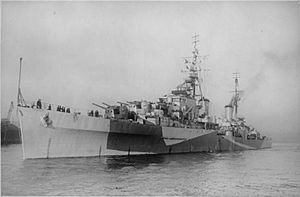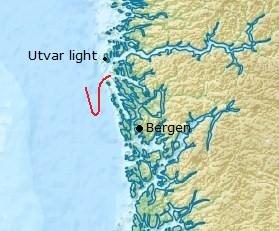Action of 28 January 1945 facts for kids
Quick facts for kids Action of 28 January 1945 |
|||||||
|---|---|---|---|---|---|---|---|
| Part of the Second World War | |||||||
 HMS Diadem in 1944 |
|||||||
|
|||||||
| Belligerents | |||||||
| Commanders and leaders | |||||||
| Strength | |||||||
| 2 light cruisers | 3 destroyers Shore batteries |
||||||
| Casualties and losses | |||||||
| 1 killed, 3 wounded 2 light cruisers lightly damaged |
55 killed, 24 wounded 1 destroyer heavily damaged 1 destroyer lightly damaged |
||||||
The Action of 28 January 1945 was a naval battle during World War II. It happened near Bergen, Norway. Two British Royal Navy light cruisers fought against three German navy (Kriegsmarine) destroyers.
This battle was one of the last naval fights between British and German warships off Norway. It was also the second-to-last surface battle for the German navy in the war. One German destroyer was badly damaged, and another had light damage. Both British cruisers also got light damage.
Just after midnight on January 28, 1945, three German destroyers were sailing from northern Norway to the Baltic Sea. The British cruisers HMS Diadem and Mauritius found them. The German destroyers Z31 and Z34 were hit by gunfire. However, the German ships were faster and got away from the British cruisers. The German warships eventually reached the Baltic Sea. Z31 was delayed because it needed repairs in Norway first.
Why the Battle Happened
The German 4th Destroyer Flotilla had three powerful destroyers: Z31, Z34, and Z38. These ships had been in northern Norway for over three years. In January 1945, Germany's war situation was getting worse. So, the destroyers were ordered to leave Norway and return to the Baltic Sea. They left Tromsø on January 25.
The British Royal Navy was often attacking German ships off Norway. British intelligence knew the German destroyers were moving. Admiral Henry Ruthven Moore, who led the British Home Fleet, was told the destroyers had sailed on January 27. He thought the German ships might travel close to the coast, which was protected by naval mines and shore guns. But they might also take a faster route further out at sea.
To be safe, Admiral Moore ordered Vice Admiral Frederick Dalrymple-Hamilton to take the cruisers Diadem and Mauritius and patrol near Bergen. This was in case the German ships used the offshore route.
The Battle Itself
The German commander, Captain H.F. von Wangenheim, chose the faster route outside the coastal islands. On the evening of January 27, British planes spotted and attacked the destroyers. But the German ships kept going.
The two naval forces saw each other at 12:48 am on January 28. The German destroyers were heading south, about 15 miles (28 km) southwest of the Utvær lighthouse. The sea was calm, and a full moon made it easy to see. The British cruisers were about 11 miles (20 km) west of the German ships. When the British saw the destroyers, they fired star shells to light up the area. Then, they turned south, moving in the same direction as the German ships.
The German destroyer Z31 was hit hard early in the fight. It was struck by seven 6-inch (152 mm) shells. This caused a fire, damaged important equipment, and destroyed its front gun turret. Z31's speed was not affected, but 55 sailors were killed and 24 were wounded. After Z31 was damaged, Commander Karl Hetz on Z34 took command of the German group.
Z34 tried to fire torpedoes at the British cruisers twice to make them change course, but it missed. Z38 also tried to launch torpedoes but had to stop because its funnel caught fire and a boiler pipe burst. Z34 was also hit near its waterline.
After Z34 was damaged, Commander Hetz decided to turn north to outrun the British cruisers. Z34 fired more torpedoes as they turned, but they still missed. The three German ships also made smoke screens to hide themselves. The two British cruisers also turned north and chased the German ships.
A running fight began. Mauritius was hit on its mess deck, but no one was hurt. Six minutes later, Diadem was hit on its boat deck. One sailor was killed, and three were wounded. The German destroyers were very fast, able to go 38 knots (70 km/h). The British cruisers were slower, with Diadem at 32 knots (59 km/h) and Mauritius at 31 knots (57 km/h).
The German ships slowly pulled ahead. Around 2:00 am, they came under the protection of shore batteries. These batteries fired at the British ships. The British ships then stopped chasing and went back to their base at Scapa Flow.
What Happened Next
Early on January 28, the German 4th Destroyer Flotilla continued its journey south and reached Bergen. Z31 went into the docks for repairs. Z34 and Z38 left Bergen that evening. The next day, planes attacked the two ships, but they were not damaged. They hid in a fjord until dark. They sailed again on the evening of January 29 and reached Kiel, Germany, on February 1.
In Bergen, Z31 got its first repairs, including removing the destroyed front turret. It left Bergen on February 8 for Horten. There, it got more repairs and its anti-aircraft guns were improved. A 4.1-inch (105 mm) gun was put where the front turret used to be. This was meant to be temporary but stayed for the rest of the war. After these repairs, Z31 finally reached Gotenhafen on March 15.
The last German destroyer in northern Norway, Z33, sailed for Germany on February 5, 1945. But it ran aground and was damaged again during an Allied air raid on February 9. After repairs, it arrived at Swinemünde on April 2.
Both the British and German navies were not happy with the results of the battle on January 28. The British were disappointed that they didn't capture or sink the German ships. Historians believe that the clear visibility and the faster speed of the German destroyers meant the British couldn't force a better outcome. The German navy also felt their destroyers should have hidden closer to the coast after being spotted by planes.
The Action of 28 January was the last battle between British and German warships in Norwegian waters during World War II. It was also the second-to-last surface battle for the German navy. Their final surface battle happened on March 18, 1945, when two British destroyers defeated a German force in the Battle of the Ligurian Sea. By the end of the war in May, most of the German navy's remaining warships were in the Baltic Sea. They helped German military operations and the evacuation of civilians.
Images for kids



